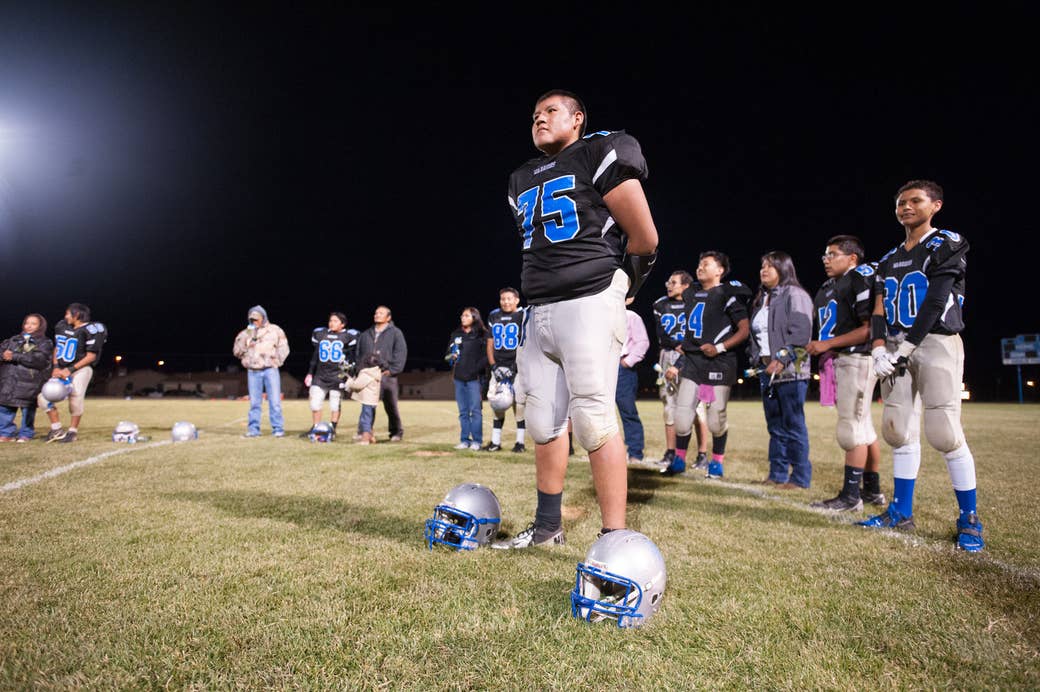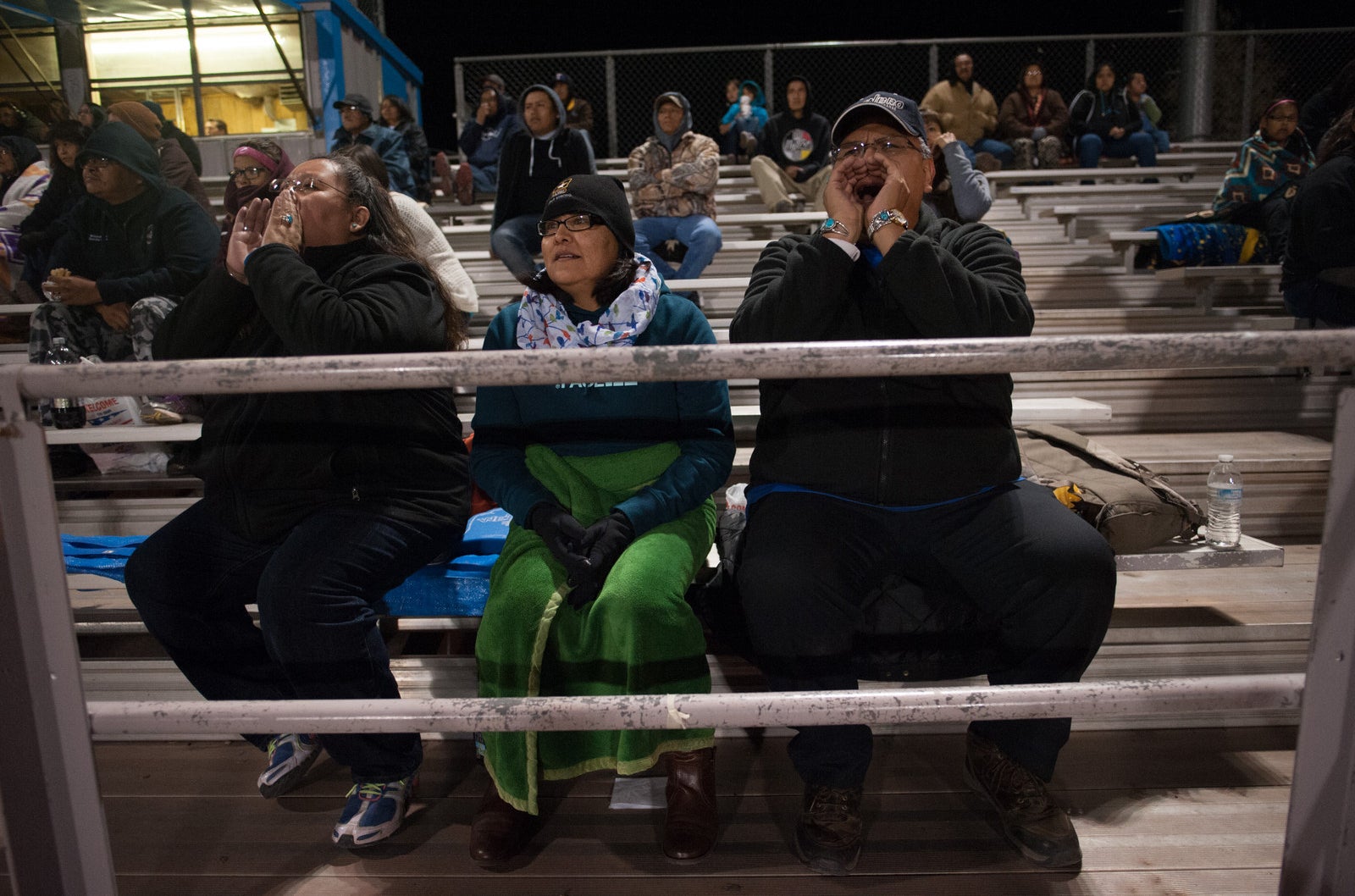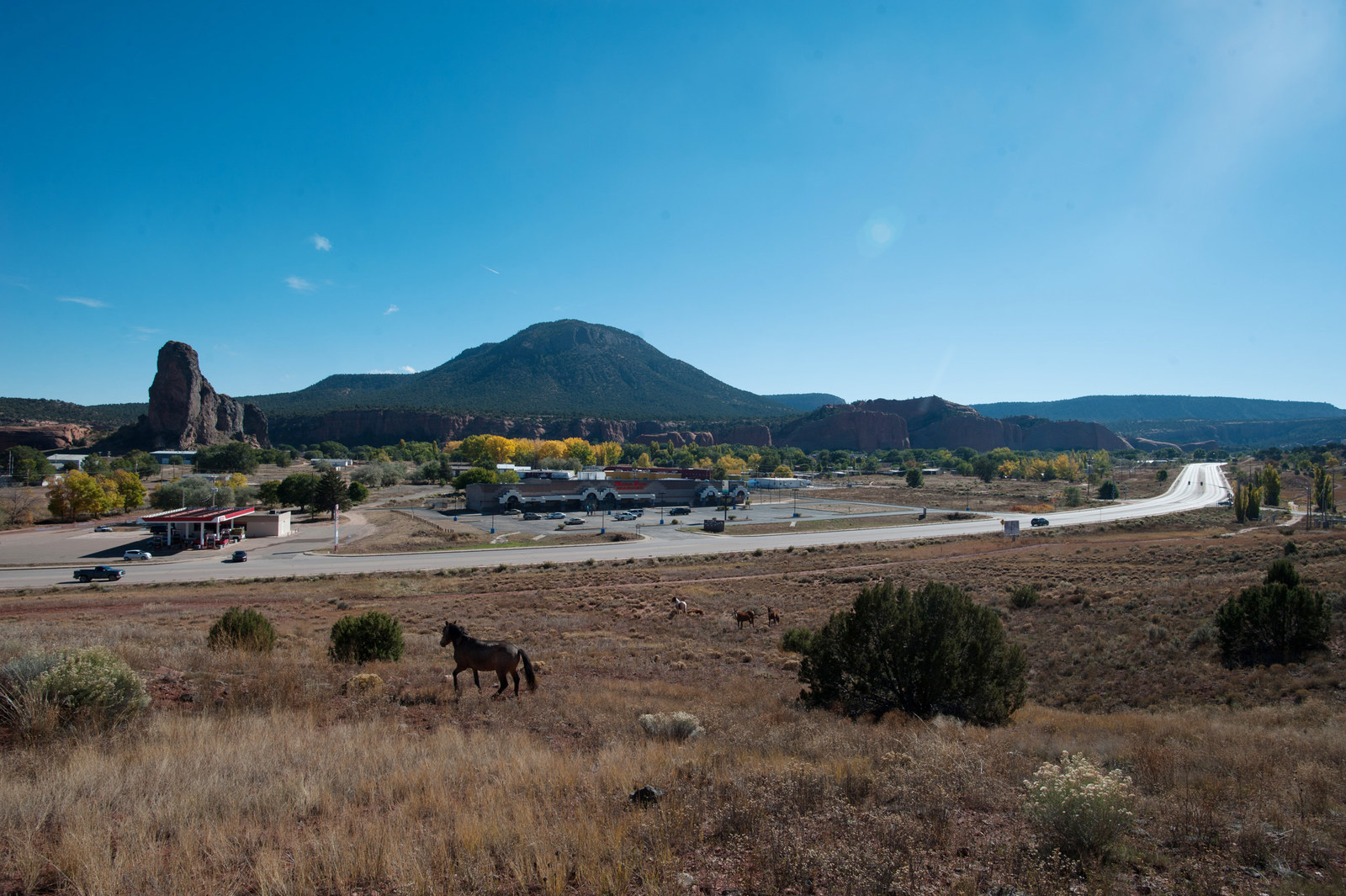
On a cold October night in Navajo, New Mexico, William Nez and his wife, Trina, and daughter, Morgan, pull up to Navajo Pine High School in their Toyota 4Runner and find a spot in the small lot close to the school’s track and football field.
Morgan, 9, bounces out of the backseat and is promptly stuffed into a purple snowsuit and handed a blue foam finger. Her father, William, zips a black fleece jacket over his Navajo Pine Warriors T-shirt, and he and Trina each grab a handle of a watercooler and head into the stands.
Navajo Pine High School is located on the Navajo Nation, a windy 40 minutes north of Route 66, and near the border of New Mexico and Arizona. Behind the field are enormous red rocks facing west that glow pink as the sun sets, just before the Warriors’ game. It is their last home football game of the season, and the last time 17-year-old Nabahitachiini Nez, William and Trina’s son, will suit up in his Warriors football uniform in front of friends and neighbors.
With 33.5 quarterback sacks during his senior season, Nez leads the nation in sacks, according to high school football website MaxPreps.com. At 6-foot-6 and 298 pounds — “not 300,” Nez clarified — he towers over his teammates and rivals, the youngest of whom are still in the eighth grade. In early weeks of his senior season, Nez was averaging a whopping six sacks per game, but as word traveled about his threatening size, players began to double cover him, and his production slowed down. In early December, Nez was named the Navajo Times Defensive Player of the Year.
During the game against the McCurdy Bobcats — who traveled four hours across New Mexico to play the Warriors — Nez plays on the offensive and defensive lines, and sometimes as a fullback. He is comically bigger than every other player on the field, and the Bobcats put two defenders on him on many plays, stifling his productivity as a pass rusher. The Warriors have only 24 players on their full roster, requiring Nez to play on nearly every snap.
The Warriors allowed McCurdy to take a quick lead, but in the stands, the Nez family is loud. William brings a pink stadium horn, which gets quickly swiped by Morgan, but his and Trina’s voices are the loudest in the hundred-person crowd gathered at the only event in town.
“Get your guy, Bona!” William screams onto the field. In conversation, the Nez family refers to Nabahitachiini as Bona, a nickname he earned as a child when his older brother, William Jr., could not pronounce the 14-letter name.
In addition to a head coach, McCurdy has a half-dozen assistant coaches dressed in red and blue in tow. The Warriors have only their head coach, Michael Hawley, who joined the team last-minute at the beginning of the 2015 season. Because of financial strain, Navajo Pine has turned over a new head coach on an annual basis. For the season, Hawley is paid $4,900.
Nez’s school, Navajo Pine, is part of the Gallup-McKinley County public school district. In 2013, only 12.9% of Navajo Pine students were reading at their grade level, with only 5.7% of male students meeting the benchmark. The scores for math proficiency were not much better. Navajo Pine graduated only 69.1% of its students in four years in 2013, with only 53.8% of males earning their diploma on time. Most high schools on the reservation in New Mexico receive similar assessments to Navajo Pine; schools in border towns and away from the reservation score higher on state benchmarks.
The caveat to Nez’s football statistics — which are self-reported by Warriors coach Hawley — is that the quality of competition from opponents and teammates likely influence and inflate his numbers. As Nez wraps his last season with the Warriors, and his family meticulously prepares for his future and education, college recruiters have not contacted them, nor have their requests for recruiters to visit their son been fulfilled. It is Nez’s hope that he will find a spot to play the game he loves in college, but for him and his family, football is a distant priority from the family’s most obvious priority: getting him a college degree.
“You have to get an overall understanding of what our tribe is experiencing in order to validate the decisions we're pushing on our kids.”
For many child athletes who grow up in underserved parts of America — as many reservations certainly are — sports can often be framed as a way out of the community. The Nez family sees football not as an escape or necessity, but as a tool to help the pursuit of the best possible education for their son.
Trina and William, self-described helicopter parents, are deeply involved in their children’s lives, including decisions about college: “You have to get an overall understanding of what our tribe is experiencing in order to validate the decisions we're pushing on our kids,” William explained.
The Warriors lost by mercy rule to McCurdy, 58–8, with three minutes left in the third quarter. McCurdy had scored 30 points during a disastrous second quarter for the Warriors, but the crowd — excluding a few players’ parents — was mostly unbothered as goodbyes were exchanged. Nez finished the game with one sack, five solo tackles, and ten assists.
As the crowd headed home, the team took a knee near the end zone, and the seniors spoke harshly to the younger players who had bickered on the field and skipped that week’s practices.
In tears, Nez stood to address the team. Instead of reprimanding his teammates, as his fellow seniors had done, he pleaded with them to invest more, try harder. “Next year, when I am gone, I want to come back here and see you win.”


The Navajo nation is a vast and varied reservation located in the Four Corners region of the Southwest. Most of the land’s 27,000 square miles are in Arizona and New Mexico, but it pokes into the southernmost region of Utah as well. Across the reservation, red rock formations loom large along rolling hills and mountains, and on a clear day, you can look dozens of miles into the expanse. The Chuska Mountains run through the reservation, with a forest made up of pine, spruce, and fir trees at the base of their climbs.
The original land of the Navajo people — or, in their language, the Diné people — was between what they call the Four Sacred Mountains, which form a large slanted rectangle just east of where the tribe mostly lives today.
The Nez family now lives in William’s childhood home in Navajo, New Mexico. Most of the homes in Navajo are small and rectangular, clumped together in close pockets along small highways.
Twenty minutes north of the tribal capital, Window Rock, Arizona, Navajo was once a bustling town with an economy and job market stimulated by a local logging company. Navajo environmental activists, however, discovered that the company’s work was endangering spotted owls, and the logging company was shut down in 1994. Today, Navajo is a town of 2,000 people, and the only businesses in town are a grocery store and a gas station.
The nearest restaurant to the Nez family home is a Denny’s 20 minutes south of Navajo in St. Michael’s, Arizona. Nabahitachiini’s knees nearly scrape the underside of the table as he sits before ordering a T-bone steak. Over lunch, William and Trina speak openly about their children, themselves, and the struggles of their community, often weaving in historical context of Navajo culture.
Trina says opposing teams have singled out Nez for as long as he’s played football. “I had to bring his birth certificate with me to his games when he was just a kid,” Trina recalls. “I was getting so many questions, I realized I needed the proof that he was the same age as everyone else on the team.” Enough doubt was cast on his age relative to his size that she learned to carry his birth certificate with her to each of his games with the youth Tony Dorsett Football League, where Nez, starting at age 8, learned to play tackle football.
Nez says he is now used to being singled out, by supporters and rivals alike. Though he speaks proudly of wearing out the players assigned to cover him, Nez places sportsmanship well above competitiveness on his list of priorities.
“I'll explain to the opposing team how to grab me. But I don't want them to get disqualified, either."
“When a guy tries to tackle me, sometimes it will be illegal contact,” Nez explains. “So I'll explain to the opposing team how to grab me. Most of them are probably shorter than me, so what they're used to doing might get them disqualified. But I don't want them to get disqualified, either."
Trina’s younger brother, Alonzo Yazzie, was a star high school football player for the Hopi High School Bruins. Large and strong like his nephew, he helped teach Nez about the sport and encouraged him to stick with it. He is the football player — NFL stars included — that Nez says he looked up to the most. Yazzie died in 2011 at age 31, after what his family says was a “sudden accident.”
Tearing up, Nez recalls his uncle's wisdom: “Me and him, we were... we were like two peas in a pod. I lost a lot of support at that time. I thought of even quitting football sometimes because of that. But I thought of what he used to tell me: ‘If you feel like quitting, don't quit. Because I will always be out there, cheering you on.’”
“It was especially hard when we lost him because some of my brothers saw in my son the same playing talent that Alonzo used to have,” Trina says. “I think that's the driving force of them wanting to drive three to four hours out and see him all the time and motivate him and say, ‘You know what, try harder. Zo — we called him Zo — played all of these positions. Make your uncle proud!’”
When Nez was a small boy, Alonzo and his other uncles often woke him before 5 a.m. and told him to get up and go outside for a run. Navajo culture prescribes early-morning runs facing east to face the deities, Trina explains. Shout as you run to make your reverence know, so they may bless you for a long and good life. Yell for the deity to hear you and bless you, no matter the hour or feeling of lead in the legs. Navajo elders pass down the tradition as a lesson of strength and endurance: Fight laziness, fight the cold to build endurance to prepare for the trials of life.
“My uncles always told me, ‘Life is gonna be hard for you,’” Nez says. “So it's best to face it right now to prepare to face it later on."
The Nez family describes themselves as lower middle class. William works for the human resources department in the Navajo Nation government, and Trina works for a utility company. Trina and William met when they were students at Diné College, and have been married 21 years.
When his and Trina's second son was born, William had the privilege of giving him his name, which, he says proudly, translates to “Tall Warrior of the Red Streak in the Water Clan.” Nez explains that while the first half of his name, Nabahi, means “warrior” in the Diné language, he sees the role as not just someone who goes out to fight in wars, but also as someone who knows when to stay put to protect the children and elders.
“It’s not just going to war,” he says. “It's not just going and killing people. It's just to protect the children of the future and elders, and also the women who carried the kids of the future. Even a warrior knows when not to go to war. He knows which fights not to fight.”
The Nez family’s top priority is education. Nearly every conversation regarding their three children can and will wind its way back to talking about education, particularly the kids earning college degrees immediately out of high school.
William graduated from the two-year college where he met Trina, and she is working on her four-year degree now. “We’ve learned from our experiences, and we know we want our kids to get their college educations earlier in life than we did,” William said.
Education on the reservation is a complex and fractured system. Three separate entities control schools on the land: state public school districts, the Bureau of Indian Education (U.S. government), and the Department of Diné Education.
Children on the reservation are subject to state-mandated curriculums, regardless of governing body, which DODE Superintendent Tommy Lewis says might not always make sense for the students. In addition, students who move from state to state, but remain within the boundaries of the reservation, are subject to different standards of education. Funding and quality of educators is another major concern on the reservation, which the DODE looks to overhaul in the next few years by implementing a reservation-wide standard that fits the students’ needs and meets state requirements.
“The reality is: The majority of students getting diplomas have reading and math scores at the fifth grade, so they can't even use those scores to get into higher ed,” Lewis says. “They can't score high enough on the ACT or SAT to get admitted. I say, ‘Golly, that's not right.’ They can't even use those diplomas to get to the job market anymore.” Using a statewide benchmark, Navajo Pine received an F grade for “College and Career Readiness” in 2013. That year, only 23% of students were successful in passing one of the three criteria outlined by the New Mexico Public Education Department. Nez is preparing to take the ACT in February.
Access to quality education is far from the primary, if only, challenge for students on the reservation. The Nez family speaks honestly, but with concern and not judgment about the many single-parent families in poverty in their community. In the 2010 Census, the number of families who identified as single-mother homes were nearly equal to the number of two-parent, male-female homes.
“For my son, the support system is there,” William said about his family. “I think what makes a person successful when it comes to Native Americans is having the full support first of all from both parents and grandparents, and then extended family like uncles. I can't speak for everyone — I can't say that none of his peers have this. Some don't. Unfortunately.”
At school, classmates often pick on Nez, calling him a nerd and mocking him because of his height. “As the captain of the football team, I know how to choose my fights,” Nez says.
His parents, despite trusting their son’s judgment in social situations, have placed a heavy restriction on their teenage boy: no school dances, no girlfriends. Not while he’s under their roof, and, preferably, not until he’s done getting his education. “I'm gonna come forward and say this was my idea," says Trina, "primarily because we've seen in our family a history of domestic violence. So when we had our boys, that was the one thing I wanted to not let them see. I made sure that my relationship with their father didn't have any domestic violence and that we talked about a lot of things. The kids see that if we have a disagreement, we talk about it.”
“I’m a helicopter mom and I'm proud of it. Children are very, very impressionable, and my role is to protect them.”
There have been girls who have expressed interest in Nabahitachiini and William Jr., and if the boys were not direct enough with the girls about not being allowed to date, Trina says she felt no hesitation to tell them herself. “I’m a helicopter mom and I'm proud of it. Children are very, very impressionable, and my role is to protect them.”
Nez’s love for football and natural athleticism make it seem almost certain that he’d pursue the sport in college, but his family is wary of using the prospect of a scholarship as a deciding factor in choosing a college. The Nez family has some financial flexibility in paying for their son’s education, but financial assistance for the right fit would put the interests of Nez and his parents in perfect harmony.
William has reached out to Arizona State University, Northern Arizona University, and the University of New Mexico, requesting that recruiters come see his son play football, but he’s heard back from none of them. Jamestown University in North Dakota offered Nez a walk-on spot on the football team, but no scholarship, and the Nez family isn’t convinced he’d have the academic support there to keep his head above water in classes.
The potential transition to life off the reservation — and in larger classes — is one the Nez family is looking to ease for their son. If Nez chooses to go to a college off the reservation, he will quickly pivot from living in a community of nearly all Native Americans to a culture where he is suddenly in the minority.
“When everyone leaves the reservation, there is a culture shock. I think that when you embed a lot of common sense, eventually they’re gonna adjust,” William says.
But when considering potential acceptance and offers from colleges and universities, William and Trina are most concerned about resources like tutoring to help their son excel in his classes. The least appealing option to the Nez family is a school that would treat Nabahitachiini as an athlete instead of a student, and they worry that, if not given the proper assistance, his grades would fall below eligibility level for a scholarship, should he have one. “If there’s no football scholarship, he’s still going to school,” William says.
Wherever he lands, Nez hopes to study some sort of electrical engineering. For a community that is already economically depressed, being able to travel across or leave the reservation for work or shopping is a privilege. The market in Navajo, the only one for 20 miles either way, sells goods at prices comparable to ones you’d find in New York City. Once a month, the Nez family loads up their car with coolers and drives three hours north to Farmington, New Mexico, to go to Sam’s Club. They buy a month’s worth of meat and other necessities and freeze them when they return to Navajo. To be resourceful in this way requires investments of time and money that many others on the reservation just can’t make.
Seeing clearly the shortcomings of his community, and the hardships they create for his neighbors, Nez hopes to return some day with the resources and ability to help out his home. His hopes are humble: Get a degree, get a job, and maybe play some football in the meantime. If football can be a tool to pursue education beyond the Nez family’s current means, it will be a bonus.

The day after Nez’s final home football game of his senior year, the family drives out to an area the family calls the Road to Nowhere, a remote stretch of land just 10 minutes east of their home in Navajo. The Road to Nowhere has recently become a road to somewhere, with construction extending the road toward Fuzzy Mountain and Bowl Canyon. William points to the shrubbery that line Fuzzy Mountain, joking that in naming landmarks, “Navajos are pretty straightforward.” A series of rock formations lines the road, and Nez talks about coming out here with his older brother — before he went away to school — to eat sandwiches and watch eagles perch on the edges of the formations.
His little sister, Morgan, yells into the expanse, listening for the echo. “Ooooohhhhhayyyyy ohhhh,” she yells. She’s recently learned about echoes, and encourages everyone else to join in.
This land is where Nez’s grandmother once lived off the land, William says sentimentally. Nez and his older brother used to come out to this place to eat sandwiches and watch eagles perch on the edges of the red plateaus. A cluster of ranch animals — steer, horses, and a single goat — grazes freely on the grass, aware of, but unconcerned with the humans nearby.
It is places like this isolated stretch of land where phones read “No Service.” Nez is quiet while his sister yells into the air. He is reserved by nature, but when he speaks of the lack of communication and transportation infrastructure on the Navajo nation, it is clear he is paying very close attention. Without living elsewhere, Nez has developed an acute understanding of his community — and the resources afforded to them — versus those off the reservation.
Nez is not sure yet where he will go to college, or if he will have the opportunity to continue playing football. In his years at Navajo Pine, his community has rallied behind him as he lined up for nearly every snap played in his four years on the football team. As Nez pursues his education and early stages of his career, away from his family and community for the first time, his eventual goal is to return to the Navajo nation to reinvest that support.
Proudly, Nez offers a reminder of what being a warrior — in name, and in sport — means to him: “Warriors sometimes leave, but when they return, they protect and support the children of the future.”

CORRECTION
The southernmost portion of Utah is part of the Navajo nation; a previous version of the story misstated which states were included in the region.
